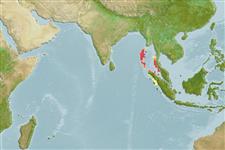Common names from other countries
>
Acanthuriformes (Surgeonfishes) >
Siganidae (Rabbitfishes)
Etymology: Siganus: Latin, siganus = a fish, rabbit fish; by the similarity of the nose (Ref. 45335).
Environment: milieu / climate zone / depth range / distribution range
Ökologie
seewasser riff-verbunden; tiefenbereich 2 - 30 m (Ref. 90102), usually 3 - 30 m (Ref. 27115). Tropical; 24°C - 28°C (Ref. 27115); 15°N - 0°N
Eastern Indian Ocean: Thailand, including the Similan Islands to Java, Indonesia.
Size / Gewicht / Alter
Maturity: Lm ? range ? - ? cm
Max length : 24.0 cm SL Männchen/unbestimmt; (Ref. 48637)
Rückenflossenstacheln (insgesamt): 13; Rückenflossenweichstrahlen (insgesamt): 10; Afterflossenstacheln 7; Afterflossenweichstrahlen: 9; Wirbelzahl: 23. Ocular band dark chocolate brown to black; a broad white arc running from isthmus and thorax to bases of 2nd - 4th dorsal spines; posterior to white band, body brown or gray dorsally, whitish below. Spines stout, not very pungent and venomous. Preopercular angle 120°; strong overlapping scales cover cheeks, 8 or 9 rows deep below center of orbit; midline of thorax fully scaled. Opening of anterior nostril borne on a very short tube which is taller posteriorly.
Inhabits coral reefs and feeds on algae and small invertebrates. Adults occur in pairs, juveniles secretive in corals (Ref. 48637). Sometimes solitary (Ref. 90102). Maximum depth from Ref. 027115.
Life cycle and mating behavior
Geschlechtsreife | Fortpflanzung | Ablaichen | Eier | Fecundity | Larven
Woodland, D.J., 1990. Revision of the fish family Siganidae with descriptions of two new species and comments on distribution and biology. Indo-Pac. Fish. (19):136 p. (Ref. 1419)
IUCN Rote Liste Status (Ref. 130435)
CITES (Ref. 128078)
Not Evaluated
Bedrohung für Menschen
Harmless
Nutzung durch Menschen
Aquarium: Kommerziell
Mehr Information
NamenSynonymeMetabolismusRäuberÖkotoxikologieFortpflanzungGeschlechtsreifeAblaichenFecundityEierEientwicklung
ReferenzenAquakulturAquakultur ProfilZuchtlinienGenetikElectrophoresesVererbbarkeitKrankheitenVerarbeitungMass conversion
PartnerBilderStamps, Coins Misc.LauteCiguateraGeschwindigkeitSchwimmstilKiemenoberflächeOtolithsGehirngrößeSehfähigkeit
Tools
Zusatzinformationen
Download XML
Internet Quellen
Estimates based on models
Preferred temperature (Ref.
115969): 28.2 - 29.2, mean 28.7 (based on 36 cells).
Phylogenetic diversity index (Ref.
82804): PD
50 = 0.5000 [Uniqueness, from 0.5 = low to 2.0 = high].
Bayesian length-weight: a=0.01445 (0.00650 - 0.03213), b=3.08 (2.90 - 3.26), in cm Total Length, based on LWR estimates for this Genus-body shape (Ref.
93245).
Trophic level (Ref.
69278): 2.7 ±0.29 se; based on food items.
Widerstandsfähigkeit (Ref.
120179): hoch, Verdopplung der Population dauert weniger als 15 Monate. (Preliminary K or Fecundity.).
Fishing Vulnerability (Ref.
59153): Low vulnerability (19 of 100).
